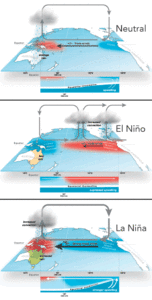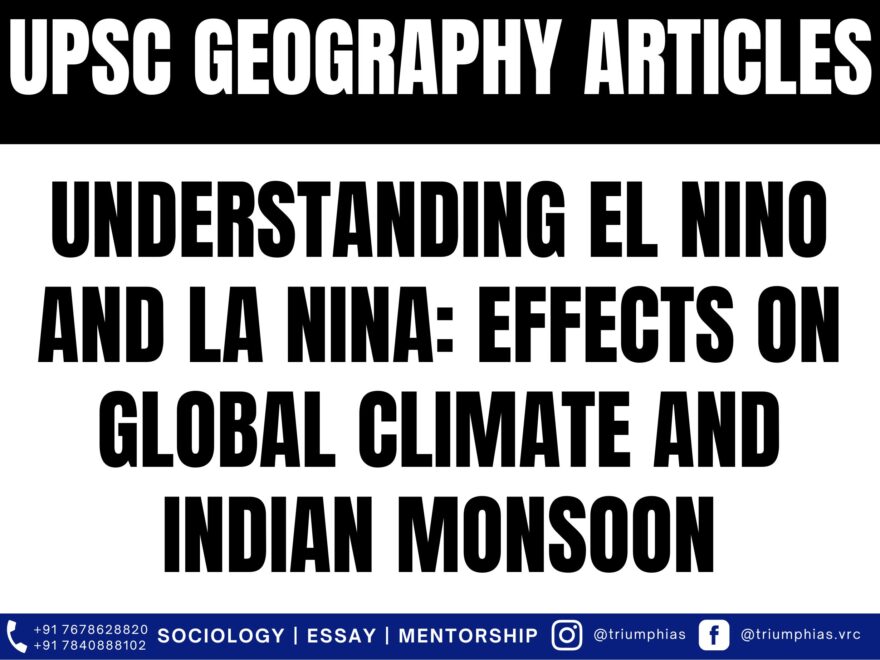EI-nino and La-nina
(Relevant for Geography section of General Studies Paper Prelims/Mains)

El Nino and La Nina are intricate meteorological patterns resulting from fluctuations in ocean temperatures within the Equatorial Pacific Region. They represent contrasting stages within the El Nino-Southern Oscillation (ENSO) cycle. The ENSO cycle elucidates the temperature variations between the ocean and atmosphere in the east-central Equatorial Pacific. El Nino and La Nina occurrences typically endure for nine to twelve months, though certain extended events can persist for years. El Nino denotes a climatic pattern characterized by the abnormal warming of surface waters in the eastern tropical Pacific Ocean.
It constitutes the “warm phase” of the broader phenomenon termed the El Nino-Southern Oscillation (ENSO). It takes place more frequently compared to La Nina. La Nina, the “cool phase” of ENSO, represents a pattern involving the anomalous cooling of the tropical eastern Pacific. Unlike El Niño, which usually subsides within a year, La Nina events might continue for a period ranging from one to three years. Both phenomena usually reach their zenith during the winter of the Northern Hemisphere.
El Nino
- El Nino was initially identified by Peruvian fishermen along the coast of Peru when they noticed the emergence of abnormally warm water.
- The Spanish settlers named it El Nino, which translates to “the little boy” in Spanish. Over time, El Niño began to encompass not only the warming of coastal surface waters but also irregular and intense climate shifts.
- El Nino events do not follow a consistent cycle, making them unpredictable and occurring sporadically within intervals of two to seven years. Climatologists determined that El Nino coincides with the Southern Oscillation.
- The Southern Oscillation pertains to alterations in air pressure over the tropical Pacific Ocean. As the eastern tropical Pacific’s coastal waters become warmer (El Niño), the atmospheric pressure above the ocean decreases. Climatologists label these interconnected occurrences as the El Niño-Southern Oscillation (ENSO).
La –nina
- La Nina translates to “The Little Girl” in Spanish. It is occasionally referred to as El Viejo, anti-El Nino, or simply as “a cold event.” La Nina occurrences signify periods of below-average sea surface temperatures across the east-central Equatorial Pacific.
- This is indicated by a decrease in sea-surface temperature of more than 0.9℉ for at least five consecutive three-month seasons. A La Nina event is observed when the water temperature in the Eastern Pacific becomes comparatively colder than usual, leading to a pronounced high pressure over the eastern equatorial Pacific.
- La Niña is brought about by the accumulation of cooler-than-normal waters in the tropical Pacific, the expanse of the Pacific Ocean between the Tropic of Cancer and the Tropic of Capricorn. It is identified by lower-than-normal air pressure over the western Pacific, contributing to heightened rainfall in those regions.
- La Nina events are also connected with wetter-than-normal conditions over southeastern Africa and northern Brazil. However, robust La Niña events can lead to catastrophic floods in northern Australia.
- Furthermore, La Nina is distinguished by higher-than-normal pressure over the central and eastern Pacific, resulting in reduced cloud formation and rainfall in that vicinity. Dryer-than-usual conditions are witnessed along the west coast of tropical South America, the Gulf Coast of the United States, and the pampas region of southern South America.
- La Niña tends to bring about milder winters in Northern Europe (especially in the UK) and colder winters in southern/western Europe, leading to snowfall in the Mediterranean region.
- North America: The impact of these conditions is most profound in continental North America.
- Wider effects include: Heightened winds along the equatorial region, particularly in the Pacific. Favorable circumstances for hurricanes in the Caribbean and central Atlantic areas. Increased instances of tornadoes in various states of the US.
- South America: La Niña triggers droughts in the South American countries of Peru and Ecuador. It generally has a positive influence on the fishing industry in western South America.
- Western Pacific: In the western Pacific, La Niña amplifies the likelihood of landfall in areas most susceptible to its effects, especially in continental Asia and China. It also gives rise to substantial floods in Australia. Elevated temperatures are observed in the Western Pacific, Indian Ocean, and off the coast of Somalia.
ENSO and India
- Potent El Niño events contribute to diminished monsoons and even droughts in India and Southeast Asia.
- La Nina: The chilly air encompasses a larger portion of India compared to the cold air of El Niño.
- During a ‘La Nina year’, the rainfall linked with the summer monsoon in Southeast Asia tends to exceed normal levels, particularly in northwest India and Bangladesh.
- This generally proves advantageous for the Indian economy, which relies on the monsoon for both agriculture and industry.
- It typically brings about colder-than-usual winters in India.
- La Nina influences the Indian subcontinent by ushering in cold air from Siberia and South China, which interacts with tropical heating to generate a north-south low-pressure system.
- The cold air from La Nina connected with this north-south trough tends to extend much farther south into India.
- This stands in stark contrast to the more northwest-southeast surge of cold air associated with El Niño.
- The pressure pattern oriented north-south results in a reduced impact of western disturbances.
- The chilly temperatures can reach as far south as Tamil Nadu, but might not affect the North East as significantly.
To master these intricacies and fare well in the Sociology Optional Syllabus, aspiring sociologists might benefit from guidance by the Best Sociology Optional Teacher and participation in the Best Sociology Optional Coaching. These avenues provide comprehensive assistance, ensuring a solid understanding of sociology’s diverse methodologies and techniques.
El Nino, La Nina, ENSO, El Niño-Southern Oscillation, global climate, Indian monsoon, Equatorial Pacific, temperature variations, atmospheric pressure, climate pattern, warm phase, cool phase, sea surface temperatures, Southern Oscillation, air pressure fluctuations, global weather, rainfall, droughts, floods, agriculture, industry, Indian economy, western disturbances, tropical Pacific, Best Sociology Optional Coaching, Sociology Optional Syllabus.

Choose The Best Sociology Optional Teacher for IAS Preparation?
At the beginning of the journey for Civil Services Examination preparation, many students face a pivotal decision – selecting their optional subject. Questions such as “which optional subject is the best?” and “which optional subject is the most scoring?” frequently come to mind. Choosing the right optional subject, like choosing the best sociology optional teacher, is a subjective yet vital step that requires a thoughtful decision based on facts. A misstep in this crucial decision can indeed prove disastrous.
Ever since the exam pattern was revamped in 2013, the UPSC has eliminated the need for a second optional subject. Now, candidates have to choose only one optional subject for the UPSC Mains, which has two papers of 250 marks each. One of the compelling choices for many has been the sociology optional. However, it’s strongly advised to decide on your optional subject for mains well ahead of time to get sufficient time to complete the syllabus. After all, most students score similarly in General Studies Papers; it’s the score in the optional subject & essay that contributes significantly to the final selection.
“A sound strategy does not rely solely on the popular
Opinion of toppers or famous YouTubers cum teachers.”
It requires understanding one’s ability, interest, and the relevance of the subject, not just for the exam but also for life in general. Hence, when selecting the best sociology teacher, one must consider the usefulness of sociology optional coaching in General Studies, Essay, and Personality Test.
The choice of the optional subject should be based on objective criteria, such as the nature, scope, and size of the syllabus, uniformity and stability in the question pattern, relevance of the syllabic content in daily life in society, and the availability of study material and guidance. For example, choosing the best sociology optional coaching can ensure access to top-quality study materials and experienced teachers. Always remember, the approach of the UPSC optional subject differs from your academic studies of subjects. Therefore, before settling for sociology optional, you need to analyze the syllabus, previous years’ pattern, subject requirements (be it ideal, visionary, numerical, conceptual theoretical), and your comfort level with the subject.
This decision marks a critical point in your UPSC – CSE journey, potentially determining your success in a career in IAS/Civil Services. Therefore, it’s crucial to choose wisely, whether it’s the optional subject or the best sociology optional teacher. Always base your decision on accurate facts, and never let your emotional biases guide your choices. After all, the search for the best sociology optional coaching is about finding the perfect fit for your unique academic needs and aspirations.
To master these intricacies and fare well in the Sociology Optional Syllabus, aspiring sociologists might benefit from guidance by the Best Sociology Optional Teacher and participation in the Best Sociology Optional Coaching. These avenues provide comprehensive assistance, ensuring a solid understanding of sociology’s diverse methodologies and techniques. Sociology, Social theory, Best Sociology Optional Teacher, Best Sociology Optional Coaching, Sociology Optional Syllabus.
Best Sociology Optional Teacher, Sociology Syllabus, Sociology Optional, Sociology Optional Coaching, Best Sociology Optional Coaching, Best Sociology Teacher, Sociology Course, Sociology Teacher, Sociology Foundation, Sociology Foundation Course, Sociology Optional UPSC, Sociology for IAS,
Follow us :


https://t.me/VikashRanjanSociology
Find More Blogs
|
Scope of the subject and comparison with other social sciences |
|||
|
|
|
|
Modernity and social changes in Europe |


One comment